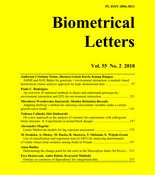
Biometrical Letters, Vol. 55(2), 2018, pp. 123-138


Genotype-by-environment interaction (GEI) is frequently encountered in multi-environment trials, and represents differential responses of genotypes across environments. With the development of molecular markers and mapping techniques, researchers can go one step further and analyse the whole genome to detect specific locations of genes which influence a quantitative trait such as yield. Such a location is called a quantitative trait locus (QTL), and when these QTLs have different expression across environments we talk about QTL-by-environment interaction (QEI), which is the basis of GEI. Good understanding of these interactions enables researchers to select better genotypes across different environmental conditions, and consequently to improve crops in developed and developing countries. In this paper we present an overview of statistical methods and models commonly used to detect and to understand GEI and QEI, ranging from the simple joint regression model to complex eco-physiological genotype-to-phenotype simulation models.

Genotype-by-environment interactions; QTL-by-environment interactions; QTL detection; Additive main effects and multiplicative interaction model; Eco-physiological genotype-to-phenotype simulation models.

